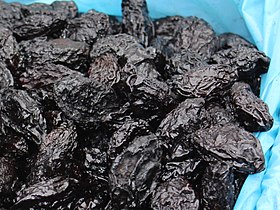
Back برقوق مجفف Arabic Pruna seca Catalan Náhkôhematôtse CHY Prŵn Welsh Trockenpflaume German Sekpruno Esperanto Ciruela pasa Spanish Aranpasa Basque آلو بخارا (خشکبار) Persian Pruneau French


| Nutritional value per 100 g (3.5 oz) | |||||||||||||||||||||||||||||||||||||||||||||||||||
|---|---|---|---|---|---|---|---|---|---|---|---|---|---|---|---|---|---|---|---|---|---|---|---|---|---|---|---|---|---|---|---|---|---|---|---|---|---|---|---|---|---|---|---|---|---|---|---|---|---|---|---|
| Energy | 1,006 kJ (240 kcal) | ||||||||||||||||||||||||||||||||||||||||||||||||||
63.88 g | |||||||||||||||||||||||||||||||||||||||||||||||||||
| Sugars | 38.13 g | ||||||||||||||||||||||||||||||||||||||||||||||||||
| Dietary fiber | 7.1 g | ||||||||||||||||||||||||||||||||||||||||||||||||||
0.38 g | |||||||||||||||||||||||||||||||||||||||||||||||||||
2.18 g | |||||||||||||||||||||||||||||||||||||||||||||||||||
| |||||||||||||||||||||||||||||||||||||||||||||||||||
| Other constituents | Quantity | ||||||||||||||||||||||||||||||||||||||||||||||||||
| Water | 31 g | ||||||||||||||||||||||||||||||||||||||||||||||||||
| †Percentages estimated using US recommendations for adults,[1] except for potassium, which is estimated based on expert recommendation from the National Academies.[2] | |||||||||||||||||||||||||||||||||||||||||||||||||||
A prune is a dried plum, most commonly from the European plum (Prunus domestica) tree. Not all plum species or varieties can be dried into prunes.[3] A prune is the firm-fleshed fruit (plum) of Prunus domestica varieties that have a high soluble solids content, and do not ferment during drying.[4] Use of the term "prune" for fresh plums is obsolete except when applied to varieties of plum grown for drying.[5]
Most prunes are freestone cultivars (the pit is easy to remove), whereas most plums grown for fresh consumption are clingstone (the pit is more difficult to remove).
Prunes are 64% carbohydrates, including dietary fiber, 2% protein, a rich source of vitamin K, and a moderate source of B vitamins and dietary minerals. The sorbitol content of dietary fiber likely provides the laxative effect associated with consuming prunes.
- ^ United States Food and Drug Administration (2024). "Daily Value on the Nutrition and Supplement Facts Labels". FDA. Archived from the original on 27 March 2024. Retrieved 28 March 2024.
- ^ National Academies of Sciences, Engineering, and Medicine; Health and Medicine Division; Food and Nutrition Board; Committee to Review the Dietary Reference Intakes for Sodium and Potassium (2019). "Chapter 4: Potassium: Dietary Reference Intakes for Adequacy". In Oria, Maria; Harrison, Meghan; Stallings, Virginia A. (eds.). Dietary Reference Intakes for Sodium and Potassium. The National Academies Collection: Reports funded by National Institutes of Health. Washington, DC: National Academies Press (US). pp. 120–121. doi:10.17226/25353. ISBN 978-0-309-48834-1. PMID 30844154. Retrieved 5 December 2024.
- ^ Growing Prunes (Dried Plums) in California: An Overview. UCANR Publications. 2007. ISBN 978-1-60107-486-7.
- ^ Richard P. Buchner (16 May 2012). Prune Production Manual. UCANR Publications. pp. 75–. ISBN 978-1-60107-702-8.
- ^ "Dehydrated Prunes Grades and Standards". Agricultural Marketing Service, US Department of Agriculture. 2017. Retrieved 15 May 2017.